A Community EcoHealth Index from EnviroAtlas Ecosystem Services Metrics
Abstract
1. Introduction
1.1. EnviroAtlas
1.2. EcoHealth
2. Materials and Methods
2.1. Conceptual Framework
2.2. EnviroAtlas Metrics
2.3. Metric Selection
2.3.1. Buffering Hazards
2.3.2. Promoting Health
2.3.3. Sustaining Capacity
2.4. Weighting and Aggregation
2.5. Comparison with Area Deprivation Index
3. Results
3.1. Weights
3.2. CEHIIndW and CEHIAvgW
3.3. CEHI and ADI
4. Discussion
5. Conclusions
Supplementary Materials
Author Contributions
Funding
Acknowledgments
Conflicts of Interest
References
- National Academies of Sciences, Engineering, and Medicine (NASEM). Communities in Action: Pathways to Health Equity; The National Academies Press: Washington, DC, USA, 2017. [Google Scholar]
- Jennings, V.; Larson, L.; Yun, J. Advancing Sustainability through Urban Green Space: Cultural Ecosystem Services, Equity, and Social Determinants of Health. Int. J. Environ. Res. Public Health 2016, 13, 196. [Google Scholar] [CrossRef] [PubMed]
- Albert, C.; Aronson, J.; Fürst, C.; Opdam, P. Integrating ecosystem services in landscape planning: Requirements, approaches, and impacts. Landsc. Ecol. 2014, 29, 1277–1285. [Google Scholar] [CrossRef]
- Summers, J.; Smith, L.; Harwell, L.; Case, J.; Wade, C.; Straub, K.; Smith, H. An Index of Human Well-Being for the U.S.: A TRIO Approach. Sustainability 2014, 6, 3915–3935. [Google Scholar] [CrossRef]
- Messner, L.C.; Jagai, J.S.; Rappazzo, K.M.; Lobdell, D.T. Construction of an environmental quality index for public health research. Environ. Health 2014, 13, 39. [Google Scholar] [CrossRef]
- Jian, Y.; Messer, L.C.; Jagai, J.S.; Rappazzo, K.M.; Gray, C.L.; Grabich, S.C.; Lobdell, D.T. Associations between Environmental Quality and Mortality in the Contiguous United States, 2000–2005. Environ. Health Perspec. 2017, 125, 355–362. [Google Scholar] [CrossRef] [PubMed]
- Fulford, R.S.; Smith, L.M.; Harwell, M.; Dantin, D.; Russell, M.; Harvey, J. Human well-being differs by community type: Toward reference points in a human well-being indicator useful for decision support. Ecol. Indic. 2015, 56, 194–204. [Google Scholar] [CrossRef]
- Pickard, B.R.; Daniel, J.; Mehaffey, M.; Jackson, L.E.; Neale, A. EnviroAtlas: A new geospatial tool to foster ecosystem services science and resource management. Ecosyst. Serv. 2015, 14, 45–55. [Google Scholar] [CrossRef]
- Jackson, L.E.; Daniel, J.; McCorkle, B.; Sears, A.; Bush, K.F. Linking ecosystem services and human health: The Ecohealth Relationship Browser. Int. J. Public Health 2013, 58, 747–755. [Google Scholar] [CrossRef]
- Pilant, A.N.; Endres, K.E.; Pardo, S.; Khopkar, A.; Rosenbaum, D.; Fizer, C.; Panlasigui, S.; Neale, A.C. Meter-Scale Urban Land Cover in EPA EnviroAtlas: Data, Methods and Applications for Assessing Ecosystem Services in Urban Landscapes. In Proceedings of the American Geophysical Union Fall Meeting 2016, San Francisco, CA, USA, 9–13 December 2016. [Google Scholar]
- De Jesus Crespo, R.; Fulford, R. Ecohealth linkages: Assessing the role of ecosystem goods and services on human health using causal criteria analysis. Int. J. Public Health 2018, 63, 81–92. [Google Scholar] [CrossRef]
- Markevych, I.; Schoierer, J.; Hartig, T.; Chudnovsky, A.; Hystad, P.; Dzhambov, A.M.; de Vries, S.; Triguero-Mas, M.; Brauer, M.; Nieuwenhuijsen, M.J.; et al. Exploring pathways linking greenspace to health: Theoretical and methodological guidance. Environ. Res. 2017, 158, 301–317. [Google Scholar] [CrossRef]
- Butler, C.D.; Friel, S. Time to Regenerate: Ecosystems and Health Promotion. PLoS Med. 2006, 3, e394. [Google Scholar] [CrossRef]
- Fong, K.C.; Hart, J.E.; James, P. A Review of Epidemiologic Studies on Greenness and Health: Updated Literature Through 2017. Curr. Environ. Health Rep. 2018, 5, 77–87. [Google Scholar] [CrossRef]
- Kondo, M.C.; Fluehr, J.M.; McKeon, T.; Branas, C.C. Urban Green Space and Its Impact on Human Health. Int. J. Environ. Res. Public Health 2018, 15, 445. [Google Scholar] [CrossRef]
- Twohig-Bennett, C.; Jones, A. The health benefits of the great outdoors: A systematic review and meta-analysis of greenspace exposure and health outcomes. Environ. Res. 2018, 166, 628–637. [Google Scholar] [CrossRef]
- Van den Bosch, M.; Ode Sang, A. Urban natural environments as nature-based solutions for improved public health—A systematic review of reviews. Environ. Res. 2017, 158, 373–384. [Google Scholar] [CrossRef]
- Frumkin, H.; Bratman, G.N.; Breslow, S.J.; Cochran, B.; Kahn, P.H., Jr.; Lawler, J.J.; Levin, P.S.; Tandon, P.S.; Varanasi, U.; Wolf, K.L.; et al. Nature Contact and Human Health: A Research Agenda. Environ. Health Perspect. 2017, 125, 075001. [Google Scholar] [CrossRef]
- Tsai, W.-L.; Davis, A.; Jackson, L.E. Associations between types of greenery along neighborhood roads and weight status in different climates. Urban For. Urban Green. 2019, in press. [Google Scholar] [CrossRef]
- Jiang, B.; Larsen, L.; Deal, B.; Sullivan, W.C. A dose–response curve describing the relationship between tree cover density and landscape preference. Landsc. Urban Plan. 2015, 139, 16–25. [Google Scholar] [CrossRef]
- De Jesus Crespo, R.; Wu, J.; Myer, M.; Yee, S.; Fulford, R. Flood protection ecosystem services in the coast of Puerto Rico: Associations between extreme weather, flood hazard mitigation and gastrointestinal illness. Sci. Total Environ. 2019, 676, 343–355. [Google Scholar] [CrossRef]
- Van den Berg, M.; Wendel-Vos, W.; Van Poppel, M.; Kemper, H.; Van Mechelen, W.; Maas, J. Health benefits of green spaces in the living environment: A systematic review of epidemiological studies. Urban For. Urban Green. 2015, 14, 806–816. [Google Scholar] [CrossRef]
- Gascon, M.; Triguero-Mas, M.; Martínez, D.; Dadvand, P.; Rojas-Rueda, D.; Plasència, A.; Nieuwenhuijsen, M.J. Residential green spaces and mortality: A systematic review. Environ. Int. 2016, 86, 60–67. [Google Scholar] [CrossRef]
- McQueen, D.V. Ethics and evidence in health promotion. In Evidence-Based Public Health: Effectiveness and Efficiency; Oxford University Press: Oxford, UK, 2010; pp. 27–42. [Google Scholar]
- Pineo, H.; Glonti, K.; Rutter, H.; Zimmermann, N.; Wilkinson, P.; Davies, M. Urban Health Indicator Tools of the Physical Environment: A Systematic Review. J. Urban Health 2018, 95, 613–646. [Google Scholar] [CrossRef]
- Organisation for Economic Co-operation and Development (OECD) Publishing. Handbook on Constructing Composite Indicators: Methodology and User Guide; Organisation for Economic Co-operation and Development (OECD) Publishing: Paris, France, 2008. [Google Scholar]
- Tran, L.T.; O’Neill, R.V.; Smith, E.R. A Generalized Distance Measure for Integrating Multiple Environmental Assessment Indicators. Landsc. Ecol. 2006, 21, 469–476. [Google Scholar] [CrossRef]
- Wolff, M.; Haase, D. Mediating Sustainability and Liveability—Turning Points of Green Space Supply in European Cities. Front. Environ. Sci. 2019, 7, 61. [Google Scholar] [CrossRef]
- Szulczewska, B.; Giedych, R.; Borowski, J.; Kuchcik, M.; Sikorski, P.; Mazurkiewicz, A.; Stańczyk, T. How much green is needed for a vital neighbourhood? In search for empirical evidence. Land Use Policy 2014, 38, 330–345. [Google Scholar] [CrossRef]
- Wolch, J.R.; Byrne, J.; Newell, J.P. Urban green space, public health, and environmental justice: The challenge of making cities ‘just green enough’. Landsc. Urban Plan. 2014, 125, 234–244. [Google Scholar] [CrossRef]
- Curran, W.; Hamilton, T. Just Green Enough: Contesting Environmental Gentrification in Greenpoint, Brooklyn. Local Environ. 2012, 17, 1027–1042. [Google Scholar] [CrossRef]
- Artmann, M.; Kohler, M.; Meinel, G.; Gan, J.; Ioja, I.C. How smart growth and green infrastructure can mutually support each other—A conceptual framework for compact and green cities. Ecol. Indic. 2019, 96, 10–22. [Google Scholar] [CrossRef]
- Wilson, E.O. Half-Earth: Our Planet’s Fight for Life; WW Norton & Company: New York, NY, USA, 2016. [Google Scholar]
- Half-Earth Cities. Available online: https://www.thenatureofcities.com/2017/12/26/half-earth-cities/ (accessed on 2 November 2018).
- McPherson, E.G.; Nowak, D.J.; Rowntree, A. Chicago’s Urban Forest Ecosystem: Results of the Chicago Urban Forest Climate Project; Gen. Tech. Rep. NE-186; Department of Agriculture, Forest Service, Northeastern Forest Experiment Station: Radnor, PA, USA, 1994; Volume 201, p. 186. [Google Scholar]
- Tiwary, A.; Refi, A.; Colls, J.J. Collection of ambient particulate matter by porous vegetation barriers: Sampling and characterization methods. Aerosol Sci. 2008, 39, 40–47. [Google Scholar] [CrossRef]
- Bealey, W.J.; McDonald, A.G.; Nemitz, E.; Donovan, R.; Dragosits, U.; Duffy, T.R.; Fowler, D. Estimating the reduction of urban PM10 concentrations by trees within an environmental information system for planners. J. Environ. Manag. 2006, 85, 44–58. [Google Scholar] [CrossRef]
- Freiman, M.T.; Hirshel, N.; Broday, D.M. Urban-scale variability of ambient particulate matter attributes. Atmos. Environ. 2006, 40, 5670–5684. [Google Scholar] [CrossRef]
- Islam, M.N.; Rahman, K.-S.; Bahar, M.M.; Habib, M.A.; Ando, K.; Hattori, N. Pollution attenuation by roadside greenbelt in and around urban areas. Urban For. Urban Green. 2012, 11, 460–464. [Google Scholar] [CrossRef]
- Health and Environmental Effects of Particulate Matter (PM). Available online: https://www.epa.gov/pm-pollution/health-and-environmental-effects-particulate-matter-pm (accessed on 4 April 2019).
- Reacher, M.; McKenzie, K.; Lane, C.; Nichols, T.; Kedge, I.; Iversen, A.; Hepple, P.; Walter, T.; Laxton, C.; Simpson, J. Health impacts of flooding in Lewes: A comparison of reported gastrointestinal and other illness and mental health in flooded and non-flooded households. Commun. Dis. Public Health 2004, 7, 39–46. [Google Scholar]
- Kessler, R.C.; Galeaz, S.; Jones, R.T.; Parker, H.A. Mental illness and suicidality after Hurricane Katrina. Bull. World Health Organ. 2006, 84, 930–939. [Google Scholar] [CrossRef]
- Bennet, G. Bristol floods 1968. Controlled survey of effects on health of local community disaster. Br. Med. J. 1970, 3, 454–458. [Google Scholar] [CrossRef]
- French, J.; Ing, R.; Von Allmen, S.; Wood, R. Mortality from flash floods: A review of National Weather Service Reports, 1969–1981. Public Health Rep. 1983, 98, 584–588. [Google Scholar]
- Manickathan, L.; Defraeye, T.; Allegrini, J.; Derome, D.; Carmeliet, J. Parametric study of the influence of environmental factors and tree properties on the transpirative cooling effect of trees. Agric. For. Meteorol. 2018, 248, 259–274. [Google Scholar] [CrossRef]
- Kaplan, S. The restorative benefits of nature: Toward an integrative framework. J. Environ. Psychol. 1995, 15, 169–182. [Google Scholar] [CrossRef]
- Lucci, P. ‘Localising’ the Post-2015 Agenda: What does it Mean in Practice? United Cities and Local Governments (UCLG), Overseas Development Institute (ODI): London, UK, 2015. [Google Scholar]
- Tran, L. An interactive method to select a set of sustainable urban development indicators. Ecol. Indic. 2016, 61, 418–427. [Google Scholar] [CrossRef]
- Greco, S.; Ishizaka, A.; Tasiou, M.; Torrisi, G. On the Methodological Framework of Composite Indices: A Review of the Issues of Weighting, Aggregation, and Robustness. Soc. Indic. Res. 2018, 141, 61–94. [Google Scholar] [CrossRef]
- Singh, G.K. Area Deprivation and Widening Inequalities in US Mortality, 1969–1998. Am. J. Public Health 2003, 93, 1137–1143. [Google Scholar] [CrossRef]
- Kind, A.J.; Jencks, S.; Brock, J.; Yu, M.; Bartels, C.; Ehlenbach, W.; Greenberg, C.; Smith, M. Neighborhood socioeconomic disadvantage and 30-day rehospitalization: A retrospective cohort study. Ann. Intern. Med. 2014, 161, 765–774. [Google Scholar] [CrossRef]
- Omernik, J.M.; Griffith, G.E. Ecoregions of the conterminous United States: Evolution of a hierarchical spatial framework. Environ. Manag. 2014, 54, 1249–1266. [Google Scholar] [CrossRef]
- Schober, P.; Boer, C.; Schwarte, L.A. Correlation coefficients: Appropriate use and interpretation. Anesth. Analg. 2018, 126, 1763–1768. [Google Scholar] [CrossRef]
- Grunewald, K.; Herold, H.; Marzelli, S.; Meinel, G.; Richter, B.; Syrbe, R.U.; Walz, U. Assessment of ecosystem services at the national level in Germany—Illustration of the concept and the development of indicators by way of the example wood provision. Ecol. Indic. 2016, 70, 181–195. [Google Scholar] [CrossRef]
- Almeter, A.; Tashie, A.; Procter, A.; McAlexander, T.; Browning, D.; Rudder, C.; Jackson, L.; Araujo, R. A Needs-Driven, Multi-Objective Approach to Allocate Urban Ecosystem Services from 10,000 Trees. Sustainability 2018, 10, 4488. [Google Scholar] [CrossRef]
- Nesbitt, L.; Meitner, M.J.; Girling, C.; Sheppard, S.R.J.; Lu, Y. Who has access to urban vegetation? A spatial analysis of distributional green equity in 10 US cities. Landsc. Urban Plan. 2019, 181, 51–79. [Google Scholar] [CrossRef]
- Engemann, K.; Pedersen, C.B.; Arge, L.; Tsirogiannis, C.; Mortensen, P.B.; Svenning, J.C. Residential green space in childhood is associated with lower risk of psychiatric disorders from adolescence into adulthood. Proc. Natl. Acad. Sci. USA 2019, 116, 5188–5193. [Google Scholar] [CrossRef]
- Hamstead, Z.A.; Fisher, D.; Ilieva, R.T.; Wood, S.W.; McPhearson, T.; Kremer, P. Geolocated social media as a rapid indicator of park visitation and equitable park access. Comput. Environ. Urban Syst. 2018, 72, 38–50. [Google Scholar] [CrossRef]
- Silva, R.A.; Rogers, K.; Buckley, T.J. Advancing Environmental Epidemiology to Assess the Beneficial Influence of the Natural Environment on Human Health and Well-Being. Environ. Sci. Technol. 2018, 52, 9545–9555. [Google Scholar] [CrossRef]
- Ramaswami, A.; Russell, A.G.; Culligan, P.J.; Sharma, K.R.; Kumar, E. Meta-principles for developing smart, sustainable, and healthy cities. Science 2016, 352, 940–943. [Google Scholar] [CrossRef]
- Keeler, B.L.; Hamel, P.; McPhearson, T.; Hamann, M.H.; Donahue, M.L.; Meza Prado, K.A.; Arkema, K.K.; Bratman, G.N.; Brauman, K.A.; Finlay, J.C.; et al. Social-ecological and technological factors moderate the value of urban nature. Nat. Sustain. 2019, 2, 29–38. [Google Scholar] [CrossRef]
- Kahn, P.H., Jr.; Friedman, B.; Gill, B.; Hagman, J.; Severson, R.L.; Freier, N.G.; Feldman, E.N.; Carrere, S.; Stolyar, A. A plasma display window?—The shifting baseline problem in a technologically mediated natural world. J. Environ. Psychol. 2008, 28, 192–199. [Google Scholar] [CrossRef]
- Trencher, G.; Karvonen, A. Stretching “smart”: Advancing health and well-being through the smart city agenda. Local Environ. 2019, 24, 610–627. [Google Scholar] [CrossRef]
- Brody, J.G.; Brown, P.; Morello-Frosch, R.A. Returning Chemical Exposure Results to Individuals and Communities. In Environmental Health Literacy; Finn, S., O’Fallon, L., Eds.; Springer: Cham, Switzerland, 2018; pp. 135–163. [Google Scholar]
- VoPham, T.; Hart, J.E.; Laden, F.; Chiang, Y.Y. Emerging trends in geospatial artificial intelligence (geoAI): Potential applications for environmental epidemiology. Environ. Health 2018, 17, 40. [Google Scholar] [CrossRef]
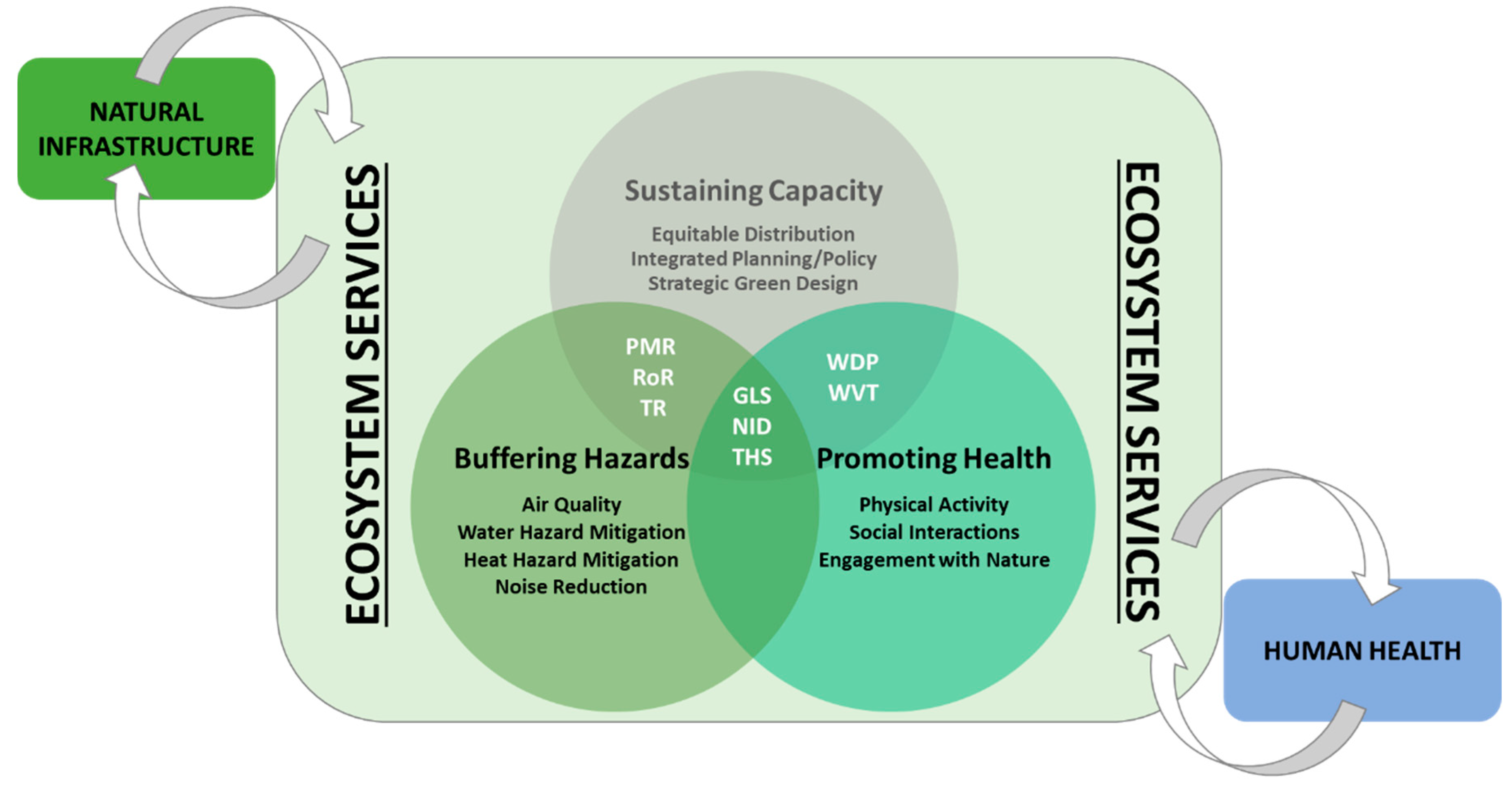
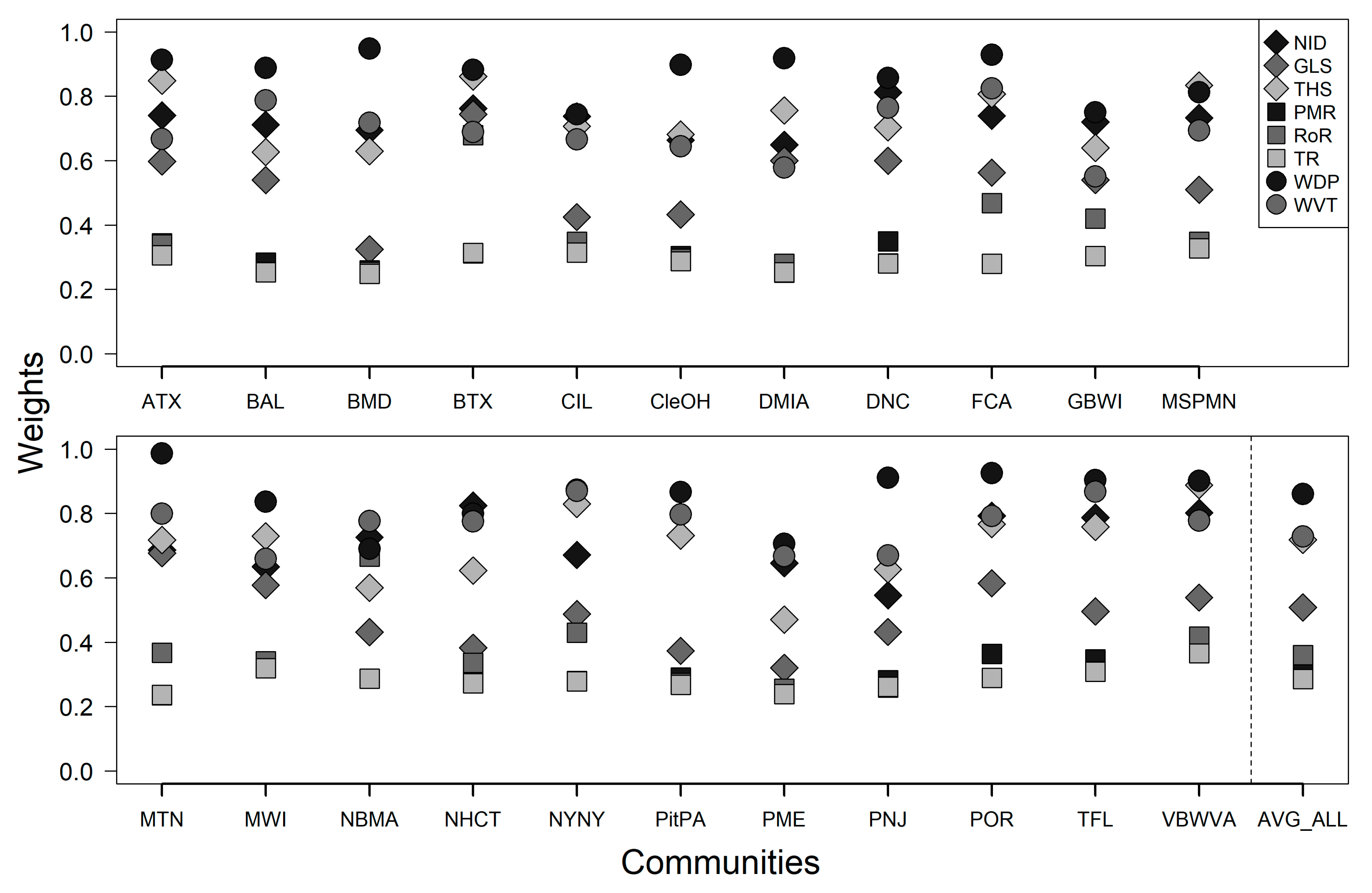

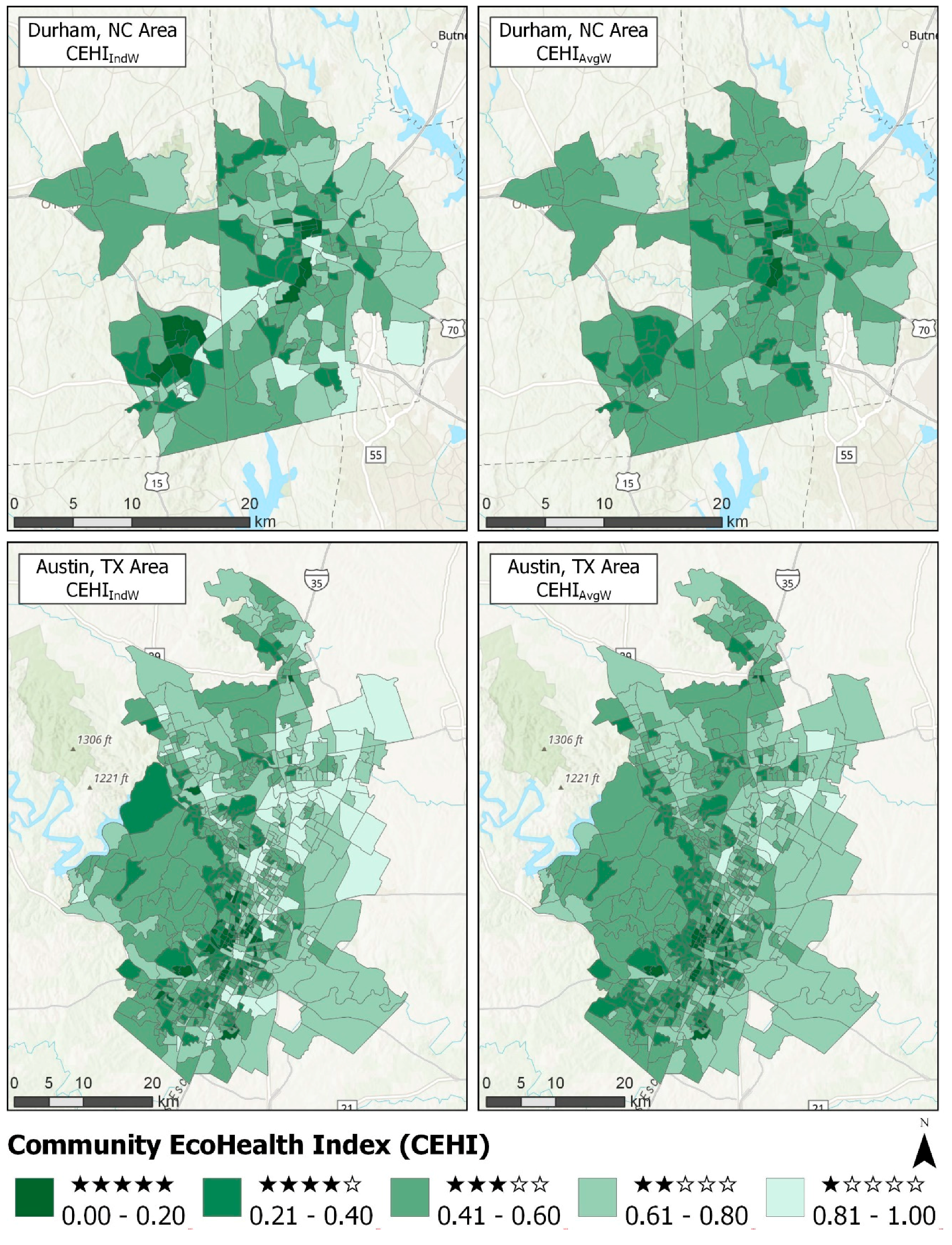
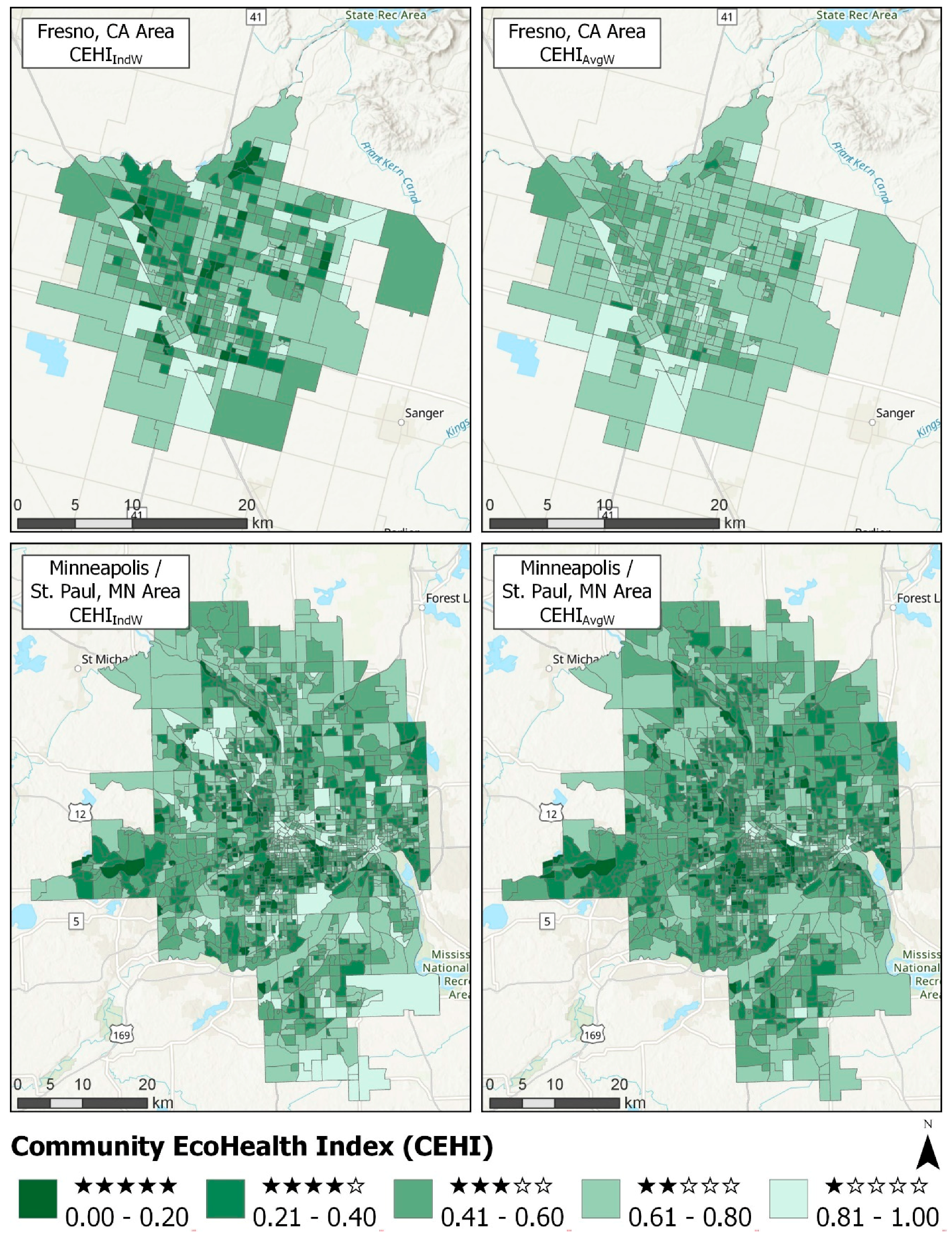
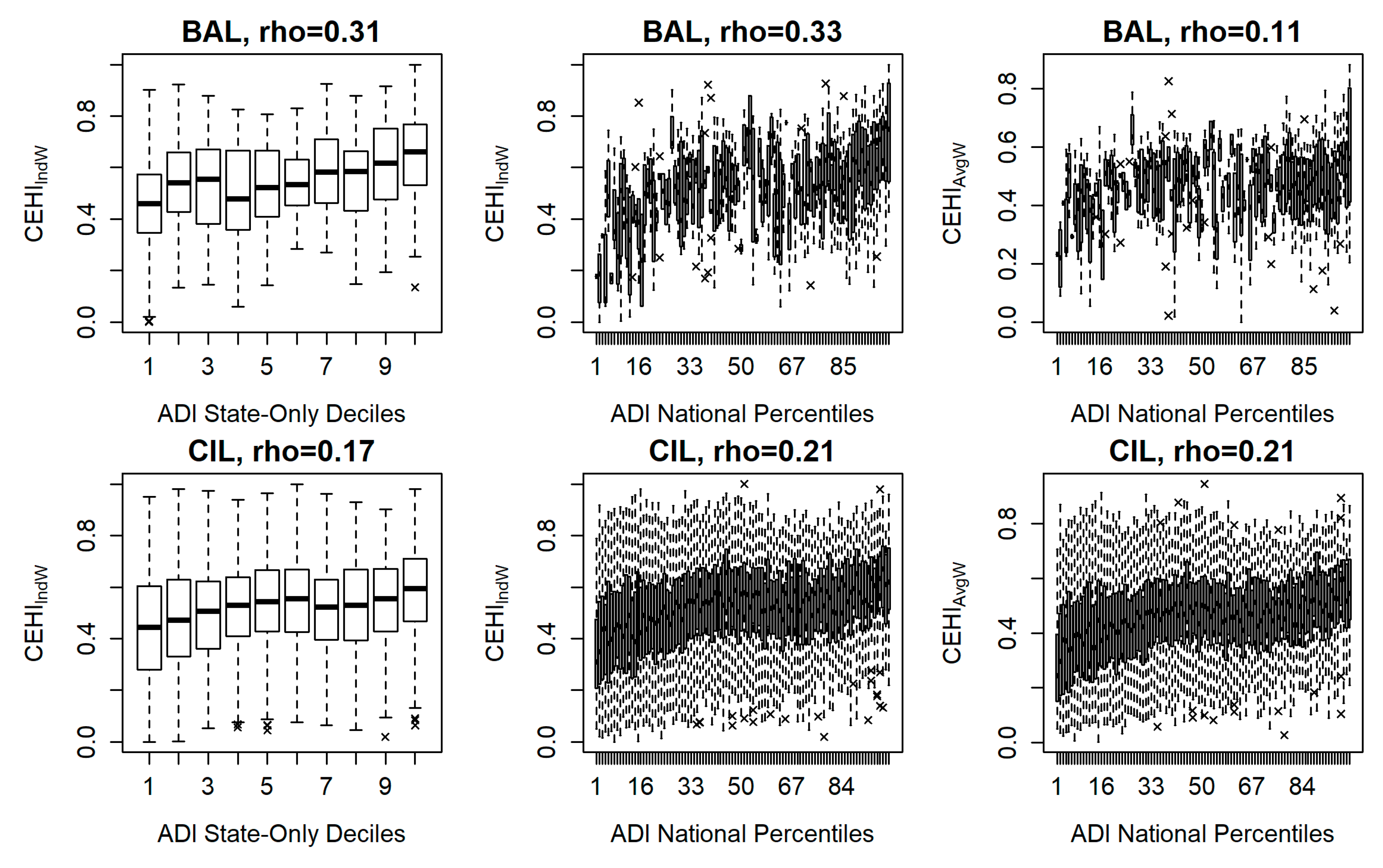
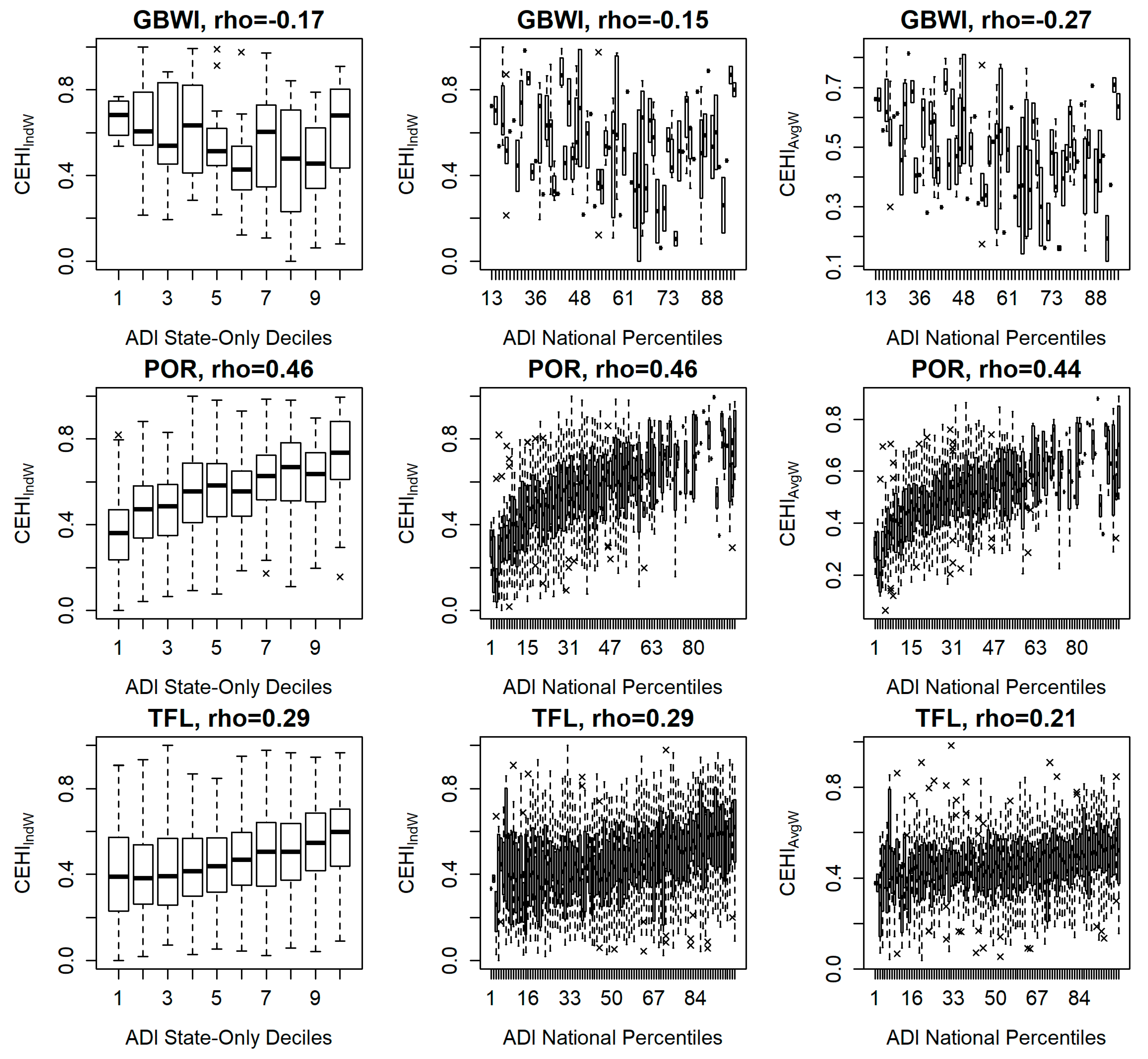
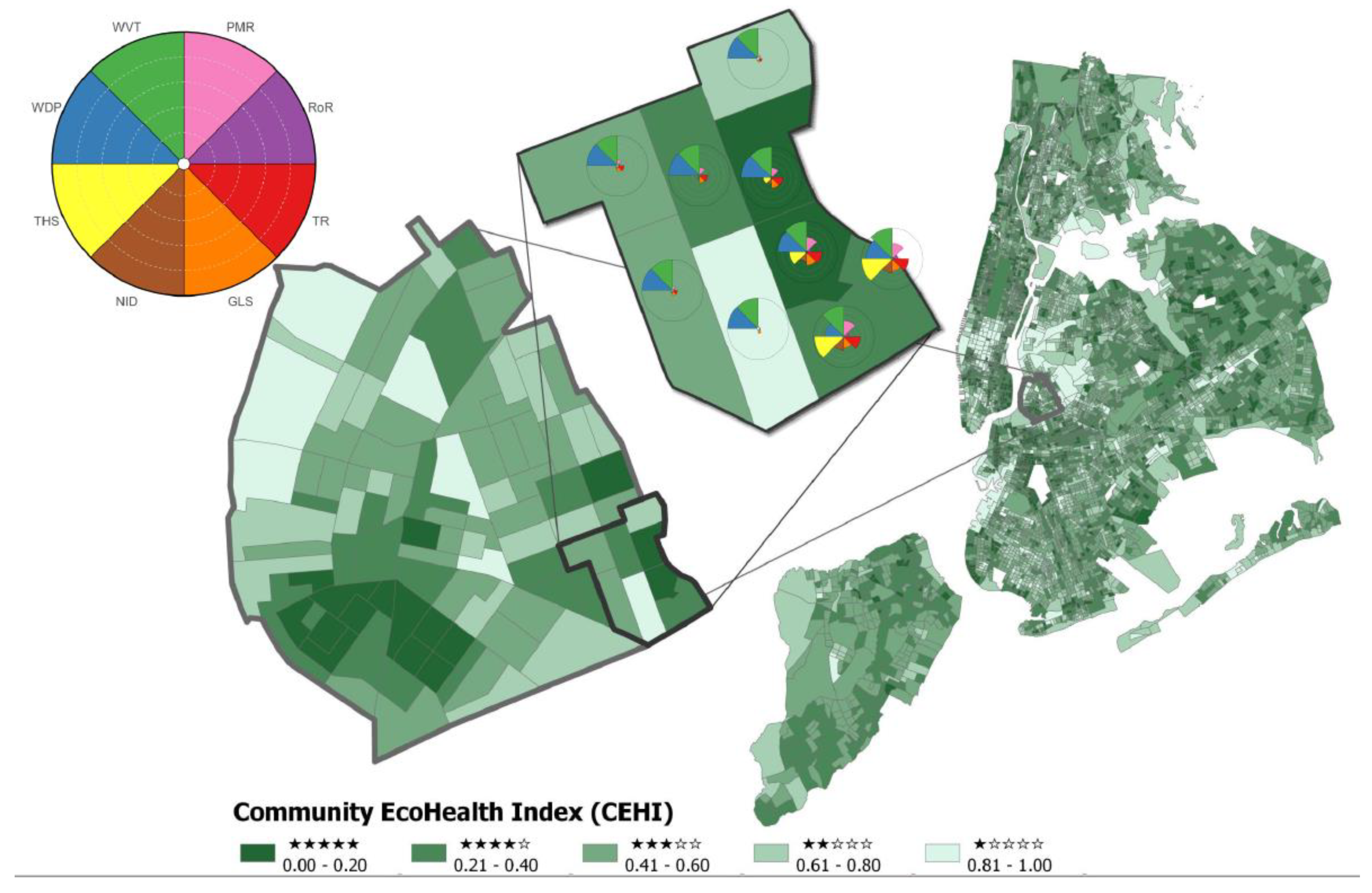
| Ecosystem Services Type | Ecosystem Services Metric | Health Indicators | EcoHealth Domains | Key Health Outcomes |
|---|---|---|---|---|
| Regulating | % PM10 Removed Annually by Tree Cover (PMR) | Air Quality Equitable Distribution Integrated Planning Strategic Green Design | Buffering Hazards Sustaining Capacity | Chronic Obstructive Pulmonary Disease |
| Regulating | % Annual Runoff Reduction due to Tree Cover (RoR) | Water Hazard Mitigation Equitable Distribution Integrated Planning Strategic Green Design | Buffering Hazards Sustaining Capacity | Gastrointestinal Illness Mental Health Mortality |
| Regulating | Average Summer Daytime Temperature Reduction in °C due to Tree Cover (TR) | Heat Hazard Mitigation Equitable Distribution Integrated Planning Strategic Green Design | Buffering Hazards Sustaining Capacity | Heat Morbidity |
| Cultural | % Residential Pop. within 500-m Walking Distance of a Park Entrance (WDP) | Physical Activity Social Interactions Engagement with Nature Equitable Distribution Integrated Planning Strategic Green Design | Promoting Health Sustaining Capacity | Stress Obesity |
| Cultural | Inverse of % Residential Pop. with <5% Views of Trees (WVT) | Engagement with Nature Equitable Distribution Integrated Planning Strategic Green Design | Promoting Health Sustaining Capacity | Cognitive Function Stress |
| Regulating Cultural | % Greenery along Low-speed (walkable) Streets (GLS) | Heat Hazard Mitigation Physical Activity Social Interactions Engagement with Nature Equitable Distribution Integrated Planning Strategic Green Design | Buffering Hazards Promoting Health Sustaining Capacity | Cardiovascular Disease Heat Morbidity |
| Regulating Cultural | % High-speed Streets Bordered by >25% Tree Buffer (THS) | Air Quality Noise Reduction Equitable Distribution Integrated Planning Strategic Green Design | Buffering Hazards Promoting Health Sustaining Capacity | Cardiovascular Disease Mental Health |
| Supporting | Natural (Greenspace + Soil & Barren + Water) to Impervious Ratio X Pop. Density in Acres (NID) | Water Hazard Mitigation Engagement with Nature Equitable Distribution Integrated Planning Strategic Green Design | Buffering Hazards Promoting Health Sustaining Capacity |
| Method | CEHIIndW | CEHIAvgW |
|---|---|---|
| Weight Calculation | Within Community | Across All Communities |
| Metric Normalization | Within Community | Across All Communities |
| Index Normalization | Within Community | Across All Communities |
| Community | Plus 2 Stars | Plus 1 Star | No Change | Less 1 Star | Less 2 Stars |
|---|---|---|---|---|---|
| ATX—Austin, TX | 228 | 506 | 14 | ||
| BAL—Birmingham, AL | 1 | 231 | 307 | 39 | |
| BMD—Baltimore, MD | 296 | 1307 | 40 | ||
| BTX—Brownsville, TX | 44 | 67 | 10 | ||
| CIL—Chicago, IL | 1869 | 4441 | 7 | ||
| CleOH—Cleveland, OH | 75 | 1194 | 171 | ||
| DMIA—Des Moines, IA | 11 | 200 | 96 | 4 | |
| DNC—Durham, NC | 3 | 76 | 95 | 19 | |
| FCA—Fresno, CA | 6 | 171 | 205 | 23 | |
| GBWI—Green Bay, WI | 51 | 100 | 4 | ||
| MSPMN—Minneapolis/St. Paul, MN | 580 | 1176 | 15 | ||
| MTN—Memphis, TN | 70 | 487 | 144 | ||
| MWI—Milwaukee, WI | 5 | 450 | 695 | 24 | |
| NBMA—New Bedford, MA | 3 | 44 | 76 | 5 | |
| NHCT—New Haven, CT | 3 | 240 | 193 | 8 | |
| NYNY—New York City, NY | 56 | 2758 | 3278 | 158 | |
| PitPA—Pittsburgh, PA | 298 | 738 | 51 | ||
| PME—Portland, ME | 21 | 109 | 16 | ||
| PNJ—Paterson, NJ | 51 | 52 | 4 | ||
| POR—Portland, OR | 271 | 815 | 90 | ||
| TFL—Tampa, FL | 400 | 1133 | 297 | ||
| VBWVA—Virginia Beach/Williamsburg, VA | 1 | 338 | 661 | 53 |
© 2019 by the authors. Licensee MDPI, Basel, Switzerland. This article is an open access article distributed under the terms and conditions of the Creative Commons Attribution (CC BY) license (http://creativecommons.org/licenses/by/4.0/).
Share and Cite
Cochran, F.; Jackson, L.; Neale, A.; Lovette, J.; Tran, L. A Community EcoHealth Index from EnviroAtlas Ecosystem Services Metrics. Int. J. Environ. Res. Public Health 2019, 16, 2760. https://doi.org/10.3390/ijerph16152760
Cochran F, Jackson L, Neale A, Lovette J, Tran L. A Community EcoHealth Index from EnviroAtlas Ecosystem Services Metrics. International Journal of Environmental Research and Public Health. 2019; 16(15):2760. https://doi.org/10.3390/ijerph16152760
Chicago/Turabian StyleCochran, Ferdouz, Laura Jackson, Anne Neale, John Lovette, and Liem Tran. 2019. "A Community EcoHealth Index from EnviroAtlas Ecosystem Services Metrics" International Journal of Environmental Research and Public Health 16, no. 15: 2760. https://doi.org/10.3390/ijerph16152760
APA StyleCochran, F., Jackson, L., Neale, A., Lovette, J., & Tran, L. (2019). A Community EcoHealth Index from EnviroAtlas Ecosystem Services Metrics. International Journal of Environmental Research and Public Health, 16(15), 2760. https://doi.org/10.3390/ijerph16152760






